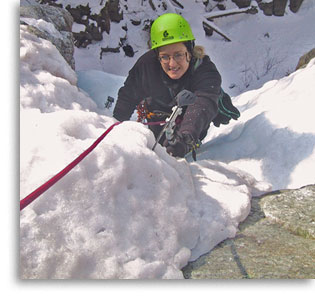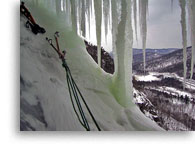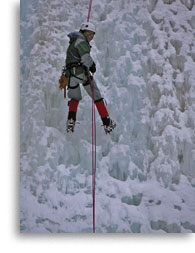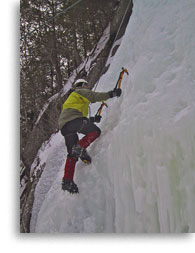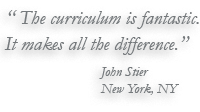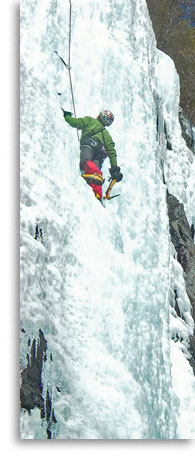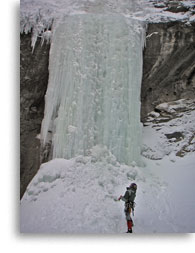
|
Ice Mastery Method |
||||||||||||||||||
|
The Ice Mastery Method is our own unique methodology for teaching ice climbing. Employing structured experiential learning, it offers an efficient learning path climbers can follow from their first day on the ice to the world’s classic ice climbs. Although you can become a competent rock climber without ever climbing ice, all capable ice climbers must also possess solid rock climbing skills. You don’t have to climb ice long to realize it is as much a variation on rock climbing as its own activity. Many technical skills, such as belaying and anchoring carry over from rock to ice with only minor adaptation required. Because of this similarity, our Ice Mastery Method incorporates a number of the same skills we teach in our Rock Mastery Method. |
|
|||||||||||||||||
|
Similarities notwithstanding, ice climbing takes place on a changeable medium, unlike anything found in rock climbing. A major part of learning to be a competent ice climber includes learning about ice and its fickle nature. The inconsistency of ice can be unsettling for those used to climbing on surfaces that are, quite literally, “solid as a rock”. Practices that rock climbers commonly rely on are sometimes not possible, or far riskier, on ice. Throwing away “rock climbing logic” and replacing it with thinking more appropriate to the medium at hand is an essential step required to build reliable ice climbing judgment skills. Moving on ice, with crampons and ice tools, has no direct counterpart in rock climbing. This equipment does not allow for the same kind of tactile feedback bare hands and soft rock shoes permit. Learning to feel the medium “through” ice tools and crampons requires careful attention to technique, something we address in various ways, throughout our progression of instruction. Like the Rock Mastery Method, our Ice Mastery Method incorporates achievement milestones to help you gauge your learning progress. This incremental approach to acquiring skills and gaining independence allows you to learn as quickly as your talent, motivation and schedule will allow. It also allows you to reach an achievement plateau and remain there, perfecting your skills, until you are comfortable with the next step. To learn more about the rationale behind our instructional methodologies please go to our Promoting Effective Education page. |
|||||||||||||||||
|
Introductory Instruction - Level I To start, we present an overview of ice climbing and its relationship to rock climbing and mountaineering. We place strong emphasize on the importance of understanding the nature and properties of ice in determining risk and challenge. We spend considerable time helping you develop basic techniques for using crampons and ice tools. This early emphasis on movement skills ensures your climbing technique is built upon a sound foundation and that you learn to climb efficiently. Basic skills for following a leader on ice are also presented in this level. Specific techniques for the placement and removal of ice protection, and tactics to avoid falling ice are among the many topics we address. Throughout this level we stress the similarities and differences between rock and ice climbing. Experienced rock climbers will begin to understand why some techniques require modification for ice. All students will learn how and why rock climbing skills form the basis for developing solid ice climbing skills. Skills presented at this level are grouped into five lessons. Completion of these five lessons requires two full days of instruction. To learn about courses that offer this level of instruction please visit Ice Courses – Level I. |
|
|||||||||||||||||
|
Intermediate Instruction - Level II At the end of this level we complete our Essential Ice Climbing Skills Evaluation for each student. This formal evaluation provides written feedback and reviews the specific skills required to successfully attain our Level II milestone. In keeping with our belief that you really can’t be an ice climber without rock climbing skills, students also need to complete our rock climbing Following Skills Evaluation if they have not done so previously. Upon attaining this milestone (by successfully completing both evaluations) climbers should feel comfortable following a competent, experienced leader on multi-pitch ice climbs. Ice climbing skills presented at this level are grouped into six lessons. Completion of these six lessons requires four full days of instruction. Additional time may be needed if you have limited rock climbing experience. We believe every serious ice climber should have a solid grasp of the skills we present in Level II and this is a prerequisite for all of our Ice Guiding programs. To learn about courses that offer this level of instruction please visit Ice Courses – Level II. |
|||||||||||||||||
|
Advanced Instruction - Level III Ice Climbing Guiding The Ice Mastery Method incorporates opportunities for mileage into all of our courses, however, many people, at various points within our instructional progression, feel they need a bit more mileage to perfect their skills in a real-world setting. We can’t think of a better way to solidify ice climbing skills than to hone them while climbing with a guide who understands exactly which skills need work and exactly which climbs would best serve that goal. In this manner you can gain the mileage required to perfect your skills while simultaneously pursuing an adventure objective. To learn about guiding opportunities please visit Ice Guiding. |

|
|||||||||||||||||
|
~ Mountain Adventures In the Adirondacks Since 1985 ~ |
|||
|
Alpine Adventures, Inc. |
(518) 576-9881 |
||
